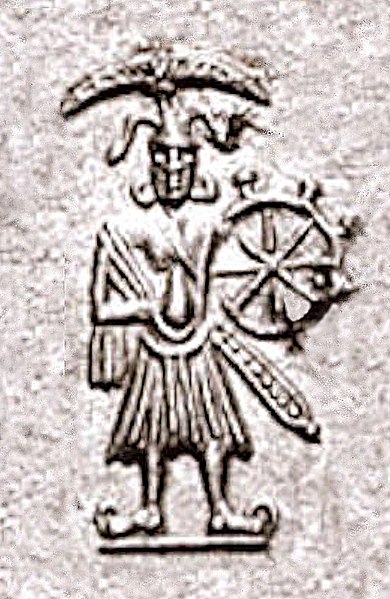Rambola Dubey, known as Tulsidas, was a Vaishnava (Ramanandi) Hindu saint and poet, renowned for his devotion to the deity Rama. He wrote several popular works in Sanskrit, Awadhi, and Braj Bhasha, but is best known as the author of the Hanuman Chalisa and of the epic Ramcharitmanas, a retelling of the Sanskrit Ramayana, based on Rama's life, in the vernacular Awadhi language.
Picture of Tulsidas published in the Ramcharitmanas, by Sri Ganga Publishers, Gai Ghat, Benaras, 1949
The birthplace of Tulsidas in Soron, Uttarpradesh, India
Tulsidas' patron deity Rama (centre) with wife Sita to his left and brother Lakshamana to the right, while Hanuman bows to his Lord
A Mughal prince visits Tulsidas. Early 18th century Sisodia dynasty painting from Udaipur, Mewar.
Vaishnavism is one of the major Hindu denominations along with Shaivism, Shaktism, and Smartism. It is also called Vishnuism since it considers Vishnu as the sole supreme being leading all other Hindu deities, that is, Mahavishnu. Its followers are called Vaishnavites or Vaishnavas, and it includes sub-sects like Krishnaism and Ramaism, which consider Krishna and Rama as the supreme beings respectively.
According to a 2010 estimate by Johnson and Grim, Vaishnavism is the largest Hindu sect, constituting about 641 million or 67.6% of Hindus.
Vaishnava traditions centre on Hindu god Vishnu (centre) and his avatars.
Heliodorus pillar in Vidisha, India.
Vāsudeva on a coin of Agathocles of Bactria, circa 190–180 BCE. This is "the earliest unambiguous image" of the deity.
The inscription of the Heliodorus pillar that was made by Indo-Greek envoy Heliodorus in 110 BCE, in what is modern Vidisha (Madhya Pradesh). The inscription states Heliodorus is a Bhagavata devoted to the "God of gods" Vāsudeva.







